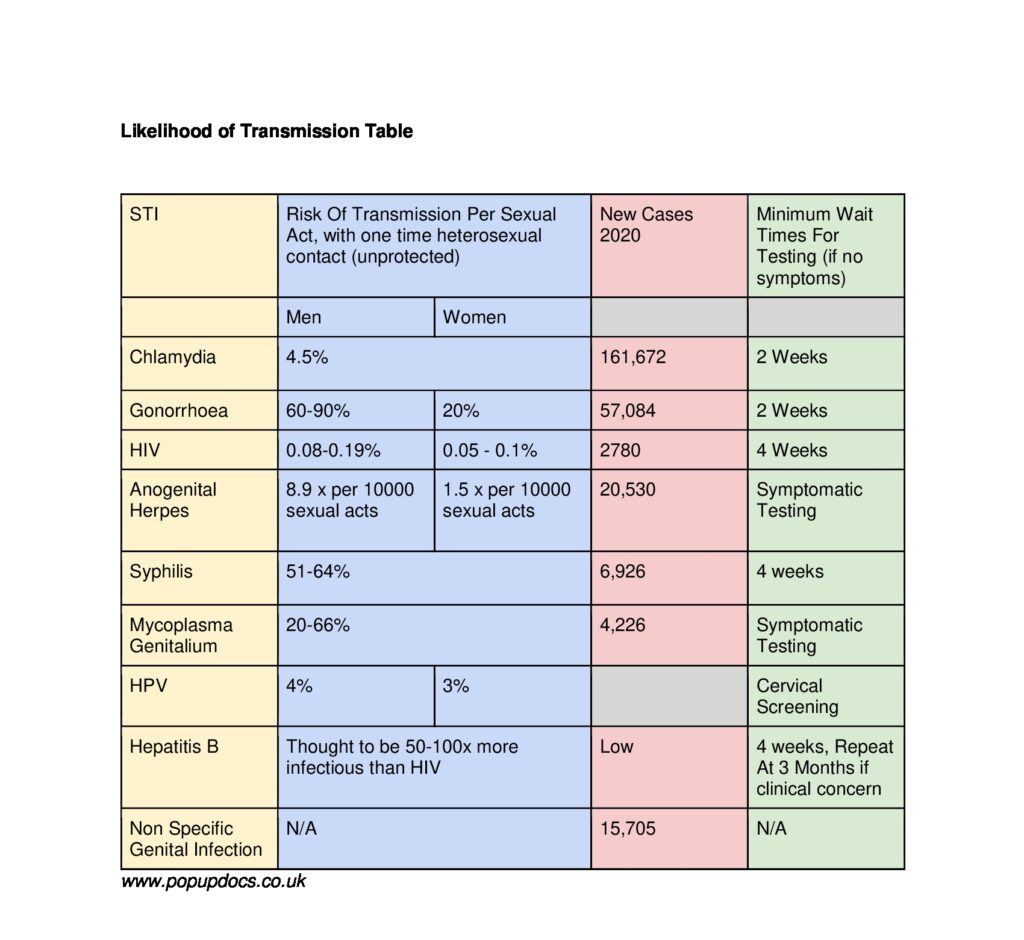Sexually Transmitted Infections – An Easy Guide

You may be very worried about developing a STI after unprotected sex, or a one night stand. But fear not, here at Pop Up Docs we’ll provide you with concise and digestible information about STIs, testing and treatment.
STIs are sexually transmitted infections. They can broadly be split into two categories:
1. Transmitted Through Sexual Contact: Chlamydia, Gonorrhoea, Syphilis (there are some others too but these are the main prevalent organisms), Hepatitis B
2. Blood Borne Viruses – HIV, Hepatitis B + C (blood borne virus blog coming soon!)
How likely am I to catch a STI?
Please see our wonderful table of likelihood of transmission, new cases in 2020, and time needed to wait for testing, unless you have developed symptoms.

How are Chlamydia and Gonorrhoea transmitted?
- unprotected vaginal, anal or oral sex
- sharing sex toys that are not washed or covered with a new condom each time they’re used
Predominantly Chlamydia:
- your genitals coming into contact with your partner’s genitals – this means you can get chlamydia from someone even if there’s no penetration, orgasm or ejaculation
- infected semen or vaginal fluid getting into your eye
What are the symptoms of an STI?
STI Symptoms In Women
At least 70% of women with chlamydia don’t notice any symptoms. If they do get symptoms, the most common include:
- pain when urinating
- unusual vaginal discharge
- pain in the tummy or pelvis
- pain during sex
- bleeding after sex
- bleeding between periods
If chlamydia is left untreated, it can spread to the womb and cause a serious condition called pelvic inflammatory disease (PID). This is a major cause of ectopic pregnancy and infertility in women. PID occurs in about 10-15% of women who do not receive treatment.
Symptoms in Men
At least half of all men with chlamydia don’t notice any symptoms. If they do get symptoms, the most common include:
- pain when urinating
- white, cloudy or watery discharge from the tip of the penis
- burning or itching in the urethra (the tube that carries urine out of the body)
- pain in the testicles
How Long Should I Wait Before I Test?
See table abov
2 weeks for Chlamydia and Gonorrhoea
4 weeks for Syphilis, HIV, and Hepatitis B (in some circumstance you may also need a repeat test at 3 months)
How Do I Test For Chlamydia and Gonorrhoea?
Men should be tested with a first catch random urine sample (at least 1 hour after their last void)
Women should be tested with a self-taken vaginal swab
How are Chlamydia and Gonorrhoea diagnosed?
Chlamydia and Gonorrhoea are diagnosed with nucleic acid amplification tests (NAATs), cell culture, and other types of tests. NAATs are the most sensitive tests to use on easy-to-obtain specimens. This includes vaginal swabs (either clinician- or patient-collected) or urine for men.
How long do I have to wait for results?
Our test times can be as fast as 4-6 hours
How are Chlamydia and Gonorrhoea Treated?
How Is Chlamydia Treated?
First-line treatment is doxycycline 100 mg twice a day for 7 days (contraindicated in pregnancy).
Recent partners also need to be notified and treated. This is defined as a patient who had anal, vaginal, or oral sex with in the 60 days before symptom onset or diagnosis. It is common for people treated to get re-infected after treatment if partners are untreated.
Patients treated with single-dose antibiotics should not have sex for seven days. Patients treated with a seven-day course of antibiotics should not have sex until they complete treatment, and their symptoms go away.
How Is Gonorrhoea Treated?
IM single 500 mg intramuscular dose of ceftriaxone.
Do I need a Repeat Test Of Cure for STIs?
Do I need a test of cure for Chlamydia post treatment?
Not routinely offered, unless patient remains symptomatic
Do I need a test of cure for Gonorrhoea post treatment?
A test of cure – is not needed for genital and rectal infections, although it can provide reassurance. However, if a person’s symptoms continue for more than a few days after receiving treatment, he or she should return to a health care provider to be reevaluated. Because re-infection is common, men and women with gonorrhea should be retested three months after treatment of the initial infection, regardless of whether they believe that their sex partners were successfully treated.
A test-of-cure is needed 7-14 days after treatment for people who are treated for pharyngeal (infection of the throat) gonorrhea. Test of cure is recommended after 2 weeks and is particularly important in the case of pharyngeal infection, due to treatment failure
